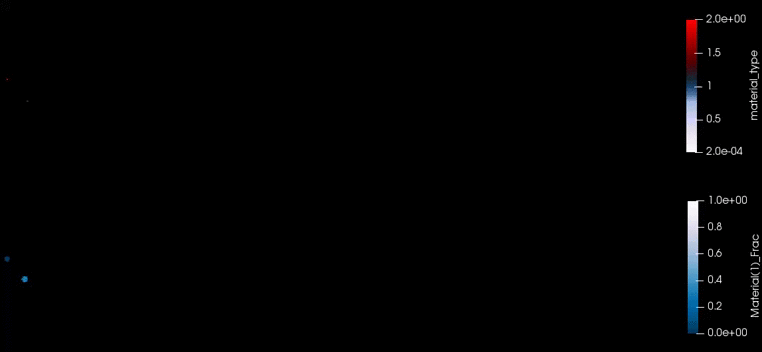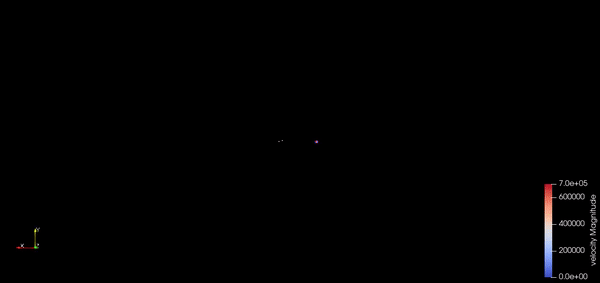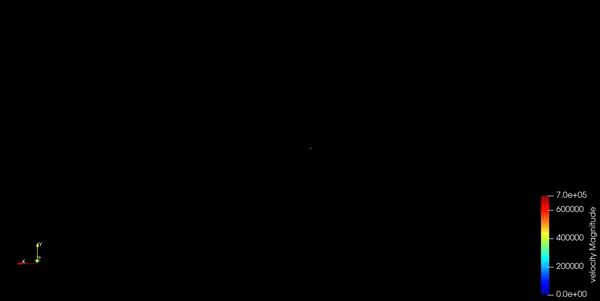
PLANETARY TIDAL DISRUPTIONS
What is a tidal disruption? In fact the phenomena of tidal forces is familiar to almost anyone, since we all know about the Earth's moon and its effects. The Earth exerts a gravitational force on the moon. As widely known, this gravitational force is proportional to the distance (squared), so the side of the moon that is close to us gets pulled more than the far side. As a result, the moon has a distorted, oblate shape. Since the moon has an elliptic and not a circular orbit around the Earth, its proximity changes as a function of time, and so does its oblateness. The moon, although only about 1% as massive as than the Earth, also exerts its own gravitational tag. That similarly causes oscillations in the Earth's own shape, but the effect is much smaller. We all know it as oceanic tides.
Now consider a more extreme situation, wherein an astronomical body comes within such proximity to a much more massive astronomical body that the tidal forces on the less massive object are so enormous they exceed its self-gravity forces and are able to break it apart. This is what we call a tidal disruption. It can involve a whole variety of astronomical objects: a star nearing a supermassive black hole, an asteroid/comet that comes within reach of a planet (like the famous comet Shoemaker-Levy 9), or a planet approaching a dense compact star such as a white dwarf or a Neutron star. The massive object has to be denser than the disrupted object, but not necessarily larger. When the disrupted object is a planet, a moon or an asteroid, we refer to the phenomena as a planetary tidal disruption.
What do planetary tidal disruptions look like? Do planetary tidal disruptions completely destroy the disrupted objects or is the tidal stripping only partial? What sort of debris are generated? What kind of discs are formed from debris bound to the massive object? I have developed a unique hybrid code that is capable of answering these questions for solid planetary objects.
Until now numerical studies that simulate planetary tidal disruptions were extremely scarce. The main problem with tracking the formation of tidal disruption debris discs is that the disrupted object does not usually form the disc in one passage around the central object. Often the disruption is partial rather than full, and at least several passages are required in order to form the disc. But even full disruptions may result in tidal streams that collapse under their own self-gravity to form large fragments. The formation process is not complete until such fragments themselves return to tidally disrupt again and again. Often multiple cycles are required until the formation process comes to a halt.
Multiple passages have always been problematic to model numerically. Since the typical orbits of disrupted objects are extremely elliptic (originating very far away from the central object), their orbital periods are long and it is thus computationally expensive to track them for many orbits. The typically employed workarounds in the past were to either artificially reduce the orbit/period (in turn affecting the disruption outcome), or extremely reduce the numerical resolution of the simulation. Both solutions are contrived and impede the accuracy of the simulation outcomes. The hybrid model requires non of these compromises.
Instead, a detailed hydrodynamical simulation is carried out for the original disrupted object and each of its tidal fragments, produced during every passage. However, the simulation domain is restricted only to the vicinity of the central object, where such details are imperative. For the reminder of the orbit, each fragment is assumed to follow an undisturbed keplerian trajectory, and thus treated analytically. The hybrid method, with proper synchronization, enables no restriction whatsoever to the original orbit, in a addition to unparalleled numerical resolution.
The animation below shows a comparison between two simulations of a terrestrial planet tidally disrupted by a white dwarf star. The top panel features a full hydrodynamical simulation, in which all particle interactions are tracked everywhere, and the bottom panel shows a hybrid simulation as described previously. The blue and white pixels denote rocky and iron materials respectively, originating from a differentiated planet. It is visually apparent (and quantitatively verified) that the outcomes of these two simulations are virtually identical, while the hybrid simulation computationally outperforms its counterpart by many orders of magnitude.

The hybrid model can be applied in order to study numerous astrophysical phenomena. Its first application was the study of formation of debris discs around white dwarfs (as seen in the above animation). This study was among the first ever to numerically model planetary tidal disruptions, and the absolute first to consider realistic orbits, multiple passages and high resolution. For more information about white dwarf disc formation and evolution see the following link.
Planetary tidal disruptions sometimes can also be like beautiful fireworks! In the following example a planet is disrupted by a host star which is not a star at all, but a double star, a tight binary. This binary is in fact composed of two compact stars, both are white dwarfs. Circumbinary planetary systems around white dwarf binaries are theoretically possible, and if planets are occasionally perturbed into close orbit of their host stars, just as it happens in single star systems, you may get ready for a wonderful display. Now the tidal forces are operating much more unpredictably, and in concert the two white dwarfs lead to various complex formation of tidal streams, in sequence. The first tidal stream might be fully bound or partially bound. It might collapse to form large tidal fragments, where during their return each is disrupted again, and each in its own way. The result is spectacular. Here are a couple of examples. The first example is more zoomed-in and the two white dwarfs are visually resolved.

